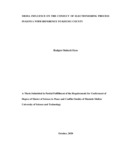| dc.description.abstract | The role of themedia in conflicts has been a concernacrossthe world. Its effecthas intensifiedenormouslyand scholarsare yet to concuron the extentof the media effect on conflicts and peace-building. The general objective of the study was to assess the media influence on the conduct of electioneering process in Kenya with reference to Kisumu County. The specific objectives of the study were to: investigate the typeof influenceof the media duringelectioneering process in Kenya with reference to Kisumu County; examine the causes and types of conflicts during electioneering process in Kenya with reference to Kisumu County and finally assessthe challenges experienced by the media during electioneering process in Kenya with reference to Kisumu County. The study adopted a conceptual model which was guided by four main theories: Libertarian theory, Galtung’s theories of structural violence and structural peace-building, Agenda Setting theoryand Social Responsibility theory. Also the study was guided by the concepts of media reporting, coverage and peace journalism. The study was limited from re-introduction of multi-party democracy in Kenya in 1992 to 2017with focus on private and public electronic and social media. The study ended in 2017as that was the year when massive electioneering violence was witnessed in Kisumu County last.The area of study was Kisumu County, Kenya specifically Nyakach and Kisumu Central sub-counties. Key government officials, security officials and journalists were key informants who were drawn from the two constituencies’ headquarters while other respondents were drawn from Kisumu residents. The sampled respondents were a total of 864. The study employed qualitative and quantitative methods for investigation. The study adopted probability (simple random) and non-probability (purposive, convenience, snowball and systematic random) sampling techniques. The data were collected through questionnaires, interviews schedule, FGDs guides and review of literature through document analysis. FGD comprised 10 homogenous key informants and six FGDs were conducted. Qualitative data were analyzed by thematic while quantitative data were analyzed using descriptive and inferential statistics. The data collected were analyzed by SPSS version 21 and Microsoft excel. The data were presented in tables, pie charts and later interpreted into meaningful information. The study found out that both print, electronic and social media were the major types of media and they had great influence on people’s opinions and behaviors during electioneering process. The media influenced people both positively and negativelybased on their daily agendas. The findings of the study revealed that Kisumu County experienced electoral and politically instigated ethnic conflicts during electioneering process. These conflicts have had greater impacts on socio-economic, psychological and health aspects of people. Finally the study found out that media experienced challenges such as insecurity, unprofessionalism, poor working conditions and brutality from citizens and police. The study, therefore, concluded that media influences people greatly during electioneering process thus determining the nature of electioneeringprocess.Therefore, the overall conclusion of this study was that the media has contributed to the peaceful electioneering process by not only educating and training, but by also addressing the historical injustices, structural and cultural conflicts.However, it was observed that these influences of media have not been without challenges.The study recommended that media be regulated and trained on peace-journalism. The study further recommended that historical injustices and structural conflicts be addressed. Youths should be involved in peace initiatives as they are the major perpetrators of violence. Finally the study recommended that all stakeholders should partner with media in enhancing peaceful electioneering process. | en_US |

